ARLINGTON, Va.—November 13, 2015 — The National Science Teachers Association and the Children’s Book Council have released their annual list of “Outstanding Science Trade Books for Students K-12: 2016.” The list represents the best trade books published in 2015 for students in kindergarten through 12th grade.

“The books on the Outstanding Science Trade Books list help students to explore the world around them,” said NSTA President Carolyn Hayes. “These amazing books will fascinate and captivate student readers with both their content and style, leaving students wanting to revisit them again and again to learn more.”
Members of a book review panel made up of science educators and literacy professionals appointed by NSTA selected 49 books for the list from a roster of roughly 200 submissions. The list of winning titles includes topics that range from Steve Jobs to flying cars and features beautifully illustrated picture books, heart-warming stories, reference and encyclopedia-type texts, and poetry.
The review panel based their decision on their extensive knowledge of the field and looked for the very best books that they believed would inspire kids. Books also meet rigorous subject matter guidelines including:
· Science content must be accurate;
· Where conflicting scientific theories exist, as many views as possible are
represented; and
· Facts are not oversimplified so that information becomes misleading.
NSTA and CBC have collaborated on the list of Outstanding Science Trade Books for Students since 1973 in an effort to help science educators access quality books that support student learning in science education. In addition to being featured on both organizations’ websites, the list will appear in the March 2016 issues of NSTA’s elementary, middle level, and high school journals for teachers.
About NSTA
The Arlington, VA-based National Science Teachers Association is the largest professional organization in the world promoting excellence and innovation in science teaching and learning for all. NSTA’s current membership includes approximately 55,000 science teachers, science supervisors, administrators, scientists, business and industry representatives, and others involved in science education.
NSTA Press® produces 25–30 new books and e-books each year. Focused on the preK–college market and specifically aimed at teachers of science, NSTA Press titles offer a unique blend of accurate scientific content and sound teaching strategies. Follow NSTA Press on Facebook for the latest information and new book releases.
About the Children’s Book Council
The Children’s Book Council (CBC) is the nonprofit trade association of children’s book publishers in North America, dedicated to supporting the industry and promoting children’s books and reading.
The CBC works annually on reading lists and round-ups to help teachers, librarians, parents, caregivers, and booksellers discover wonderful books for the kids and teens in their lives. Learn more at cbcbooks.org/reading-lists/.
We've just added 5thGradeReading.NET to our suite of GradeReading.NET sites! Find reviews of current fiction and nonfiction books, 740-1010L.
Check out 5th grade book reviews now.
Other sites:
This past weekend, I attended the National Science Teachers Association conference and it was a great way to meet my audience. Here are some specific things that I thought were a benefit of attending.
Know Your Audience. This is a photo of the convention floor, the display booths. It’s interesting to wander the aisles and think like a science teacher. I try to imagine which of the booths I would stop at and why—what would they offer to a science teacher of various levels (elementary, middle school, high school). And then apply that to my books: what do my books offer to the same person? It’s a great way to get a feel for the overall needs of an audience of teachers.
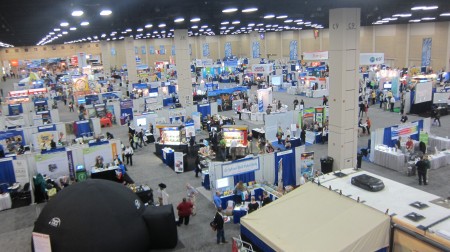
The 2013 National Science Teachers Association Convention exhibitor's hall, San Antonio, TX
Meet Your Editor. We often work long-distance with editors and a conference is a great way to meet them. Here are pictures of Sylvan Dell’s booth and staff.
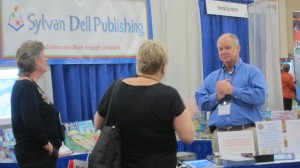
Sylvan Dell's Publisher, Lee German is a level-headed businessman who works passionately to promote and sell his author's books.
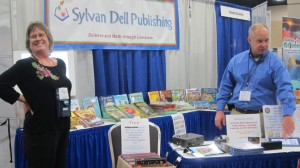
Sylvan Dell Editorial Director, Donna German. Fun, dedicated to quality--and about to become a grandmother.
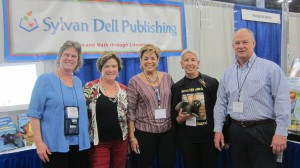
L to R: Donna German (editor), Darcy Pattison (author), Rosalyna Toth (Spanish translator for Sylvan Dell books), Terry Jennings (author), Lee German (publisher)
Meet Your Peers. On the convention floor, in sessions and just schmoozing—it’s a great way to meet other authors. We talked about everything: publishing, astronomy, advances from various publishers, Common Core, wolf snails (see Sarah Campbell’s great book), and gross things that animals do (see Melissa Stewart’s great book).
Promote Your Book. I also had a chance to promote my book on the convention floor, and in a session about the Outstanding Science Trade Books. Desert Baths—and my other titles, Prairie Storms and Wisdom, the Midway Albatross—were well received and I was fascinated to see how science teachers talked about it and how they talked about using it in the classroom. This helps me to refine how I create future books.
Network. Before the conference, I emailed various editors to see who might be attending. I wound up with an appointment with one editor and pitched an idea. The result? An invitation to submit. Hurrah!
See the Sights.
The booth across the aisle from us was Sea World. They kept bringing in live animals: bald eagle, pink flamingo, echidna, Magellan Penguins, white spotted sharks. It was a fun place to be.
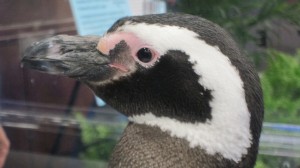
Magellan Penguin from the Sea World display at the NSTA conference.
Just at dawn, when the birds were calling a greeting to the sun, we strolled by the Alamo. Remember the Alamo! And the NSTA-San Antonio conference.
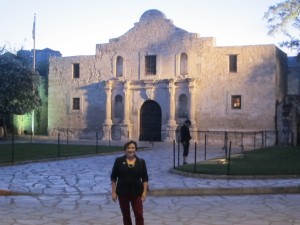
Darcy, at dawn, at the Alamo.

Spent the weekend at the National Science Teachers Conference, and talked with a room full (or not so full) of science teachers and those interested in using trade books in their science classrooms. The session wasn’t as packed as it should have been, but the discussion was no less rigorous. I met teachers from Missouri, Vermont, Wyoming, and other states who all struggle against time constraints, testing standards, and changing curriculum in their efforts to teach science as it should be taught – as an exciting exploration to satisfy curiosity about the world around us.
Catherine Thimmesh (author of Team Moon) wondered why students “check out” when a lesson or activity is labeled science. It didn’t make sense to any of us in the room – teachers or writers – who think that science in all its forms is cool. Most kids start out being curious, natural scientists. Something along the way turns them off. What can we do?
I’ve heard that kids don’t go into the sciences because they believe that it is hard. Where does that idea come from? Yes, science can be difficult, but it is also one of the few places where being wrong can be just as important as being right.
Elizabeth Rusch (author of Mighty Mars Rover) noted that we need to model that it is okay not to understand something. Our school system promotes right and wrong answers, facts for every subject.
Sarah Campbell (author of Growing Patterns) contends that if kids are taught how to think – analyze, compare, etc. -- science is just like everything else. “If you can do that, you can do science.”
I think
Sallie Wolf (author of The Robin Makes a Laughing Sound) hit the nail on the head when she said, “We don’t have time in our education system to let kids stay in that place of not understanding.” There is always a test in two weeks, another unit to move on to. Kids also aren’t taught to trust their observations.
When a group of 5th graders created a bird field guide, they had to ask, “How can we make a boring Missouri bird sound cool” (They had just read about penguins and thought they were cool.) That’s what NF writers ask every day. What other questions do we ask? How do you make something complex simple? What’s important to kids? If you don’t understand, how do you find out – what questions do you ask? What are your assumptions? How do you know what you think you know?
If we want kids to ask questions, we can’t be afraid to not know the answer. Teachers, writers and everyone need to admit, “I don’t know, but let’s find out.” And we writers can acknowledge how much we don’t know when we start a project, how that it’s exciting to us, and how we go about getting the information we need. If we are honest with kids about not knowing, perhaps they will be more comfortable with that part of learning and science won’t seem so hard.
 Okay, so I know you’re going to say I’m biased, but I’m a huge fan of Seymour Simon. As a librarian, I was always comfortable recommending his books - he was one of my reliables, an absolute go-to. Recently, I’ve had opportunities to work with him and, I have to confess, he’d have a lot of us beat in the pop culture and technology departments: Seymour knows more about Idol than I ever would and has all the latest gadgets that I’m still slightly scared of.
Okay, so I know you’re going to say I’m biased, but I’m a huge fan of Seymour Simon. As a librarian, I was always comfortable recommending his books - he was one of my reliables, an absolute go-to. Recently, I’ve had opportunities to work with him and, I have to confess, he’d have a lot of us beat in the pop culture and technology departments: Seymour knows more about Idol than I ever would and has all the latest gadgets that I’m still slightly scared of.
With that in mind, you have to check out Seymour Simon’s website and blog. Here is just a glimpse of the coolness you’ll find there:
Want to meet Seymour in person? The correct answer, of course, is yes. He’ll be at the National Science Teachers Association (NSTA) conference in San Francisco this coming weekend! On Friday, March 11th, from 3:30 pm – 5:30 pm, he’ll be accepting his award for the NSTA Outstanding Science Trade Books for Students K-12 – listen to him speak about GLOBAL WARMING. On Saturday, March 12th, he’ll be on a panel, “Science with Seymour Simon and Wendy Saul: Developing the Language of Science”, from 5:00 pm – 6:00 pm at the Moscone Center, Room 262 on Saturday. Stop by and say hi to Seymour!










